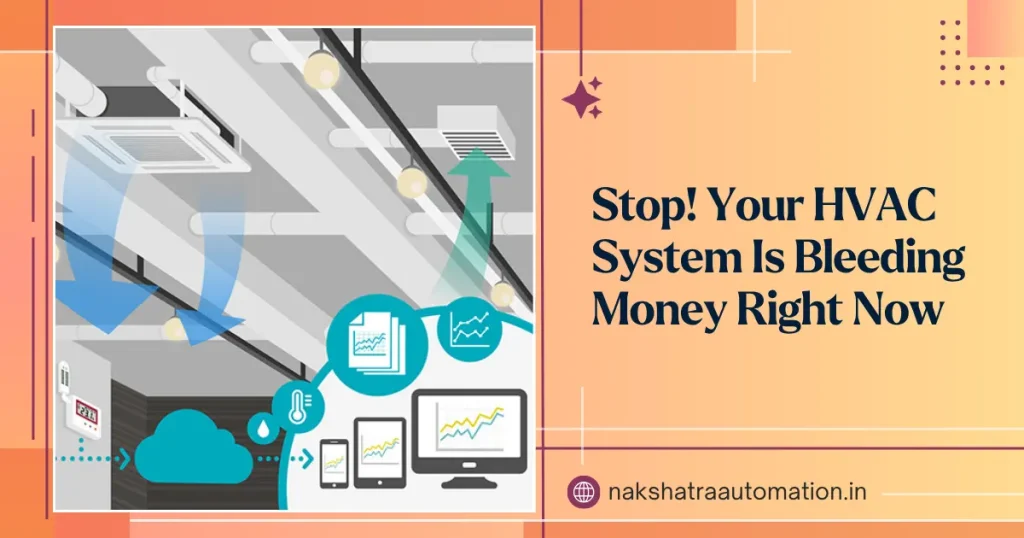Your air conditioning system is silently draining your wallet every single month. In fact, HVAC systems consume a staggering 40-60% of total energy in most buildings, making them the single largest contributor to electricity bills. In hotter climates, this figure climbs even higher, yet most buildings continue operating with outdated manual controls that waste thousands of rupees annually.
The transformation from energy guzzler to intelligent system isn’t just possible—it’s remarkably straightforward with automation technology. Here’s everything you need to know about turning your HVAC system into a smart, cost-saving powerhouse.
The Technology Stack Behind Smart HVAC
Professional HVAC automation relies on several integrated components working in harmony:
Smart Thermostats adapt temperature settings based on schedules, occupancy data, and predictive algorithms rather than fixed setpoints.
Environmental Sensors provide accurate real-time data on temperature, humidity, and air quality, enabling precise control decisions.
Occupancy Detection ensures rooms are conditioned only when actually in use, eliminating waste from heating or cooling empty spaces.
Variable Speed Drives modulate fan and compressor speeds to match exact demand rather than running at full capacity constantly.
Zone Controls allow independent temperature management for different areas, preventing the wasteful practice of conditioning unused spaces.
Seven Ways Automation Delivers Massive Energy Savings
1. Smart Scheduling Eliminates Wasteful Runtime
Automated systems follow intelligent schedules aligned with actual occupancy patterns. Instead of running continuously, your HVAC pre-cools spaces just before use and reduces output during unoccupied periods.
Energy savings: 10-30% by eliminating unnecessary operation during low-use periods.
2. Demand-Based Operation Matches Reality
Sensors continuously monitor conditions and adjust output only when necessary. If a conference room empties, the system automatically reduces airflow. When outside temperatures naturally cool, indoor cooling pauses.
Energy savings: 15-25% through precise demand matching.
3. Zoning Technology Ends Blanket Conditioning
Why cool your entire building uniformly when different areas have different needs? Zoning control allows custom temperature settings for specific rooms or floors, conditioning only where needed.
Energy savings of 20-40% by strategically targeting conditioning efforts.
4. Variable Speed Operation Stops Energy Spikes
Traditional systems run at full capacity even for minor adjustments. Variable-speed technology modulates output smoothly, avoiding the energy spikes associated with on-off cycling.
Energy savings: 10-20% through efficient modulation.
5. Free Cooling Leverages Natural Resources
Automation enables economizer mode, which uses outside air for cooling when conditions permit. During cooler periods, the system switches off compressors entirely and uses fresh air instead.
Energy savings: 5-15% depending on climate conditions.
6. Integrated Systems Multiply Efficiency
Smart buildings link HVAC with lighting and shading systems for compound benefits—motorized blinds close during peak heat, reducing cooling loads. HVAC automatically adjusts when lights indicate occupancy changes.
Energy savings: 5-10% through system coordination.
7. Predictive Maintenance Prevents Efficiency Loss
Automated monitoring detects issues such as clogged filters, dirty coils, or overworked compressors before they cause significant efficiency losses. Early intervention maintains optimal performance.
Energy savings: 5-10% through equipment optimisation
Real-World Results That Speak Volumes
Numbers tell the story better than promises. A smart office tower in Singapore achieved a 32% reduction in HVAC energy consumption after implementing IoT sensors and centralized control. A major hotel chain in India saw energy bills 20% lower following zoning- and schedule-based automation. Even residential installations report annual savings of 10-15% on HVAC electricity costs.
The Future is AI-Driven and Grid-Integrated
Next-generation HVAC automation leverages artificial intelligence and machine learning to make micro-adjustments in real-time. These systems learn from historical patterns, weather forecasts, and even electricity pricing to continuously optimize performance. Optimising Smart grid integration enables load shifting to periods when power is cheaper and cleaner.
Why This Matters Now More Than Ever
HVAC automation isn’t a luxury upgrade—it’s a financial and environmental necessity. Whether managing a home, office, educational institution, or industrial facility, smart HVAC systems deliver lower electricity bills, enhanced comfort and air quality, extended equipment lifespan, and reduced carbon footprint.
If your building still relies on manual thermostats and fixed-speed systems, you’re leaving substantial savings on the table every single day.
Ready to transform your HVAC system from energy drain to efficiency engine? Nakshatra Automation specializes in intelligent climate control solutions that deliver measurable results. Our proven automation strategies have helped businesses reduce HVAC energy consumption by up to 40% while improving comfort and reliability.

